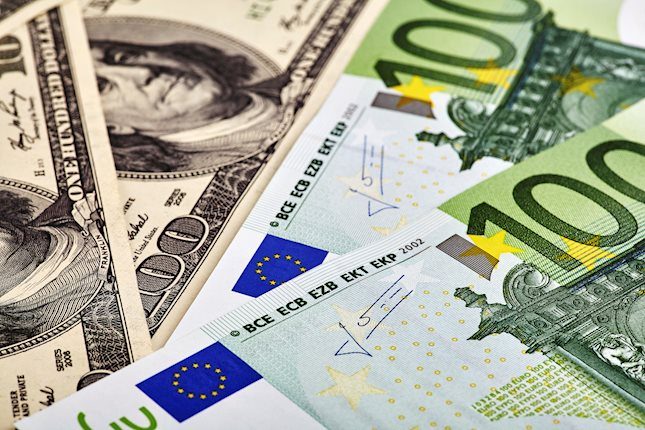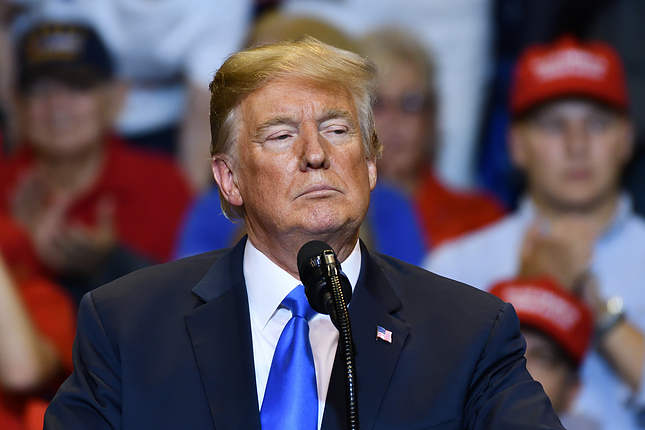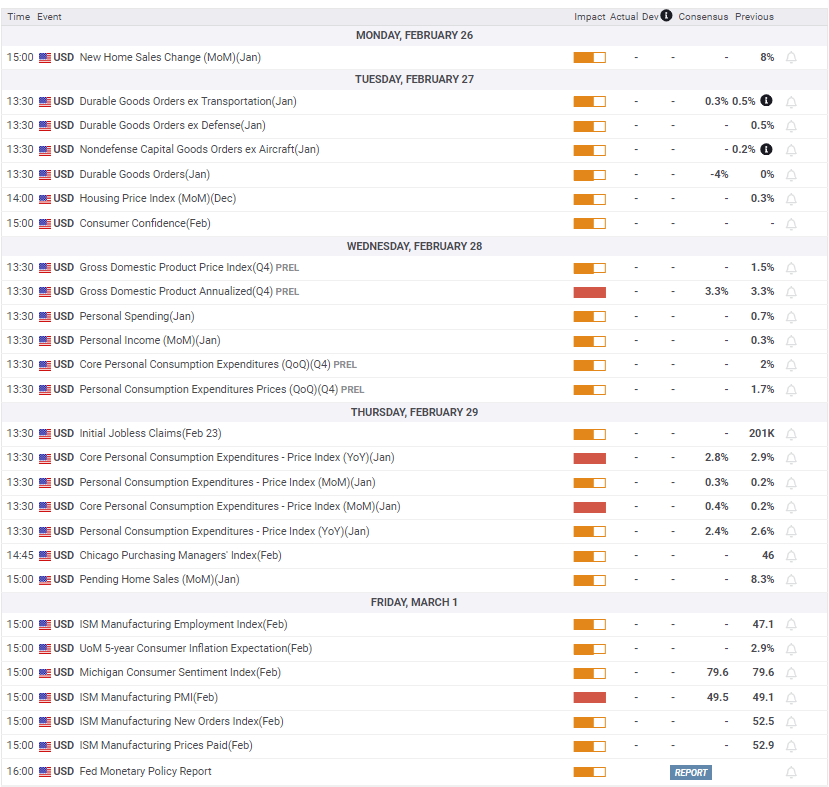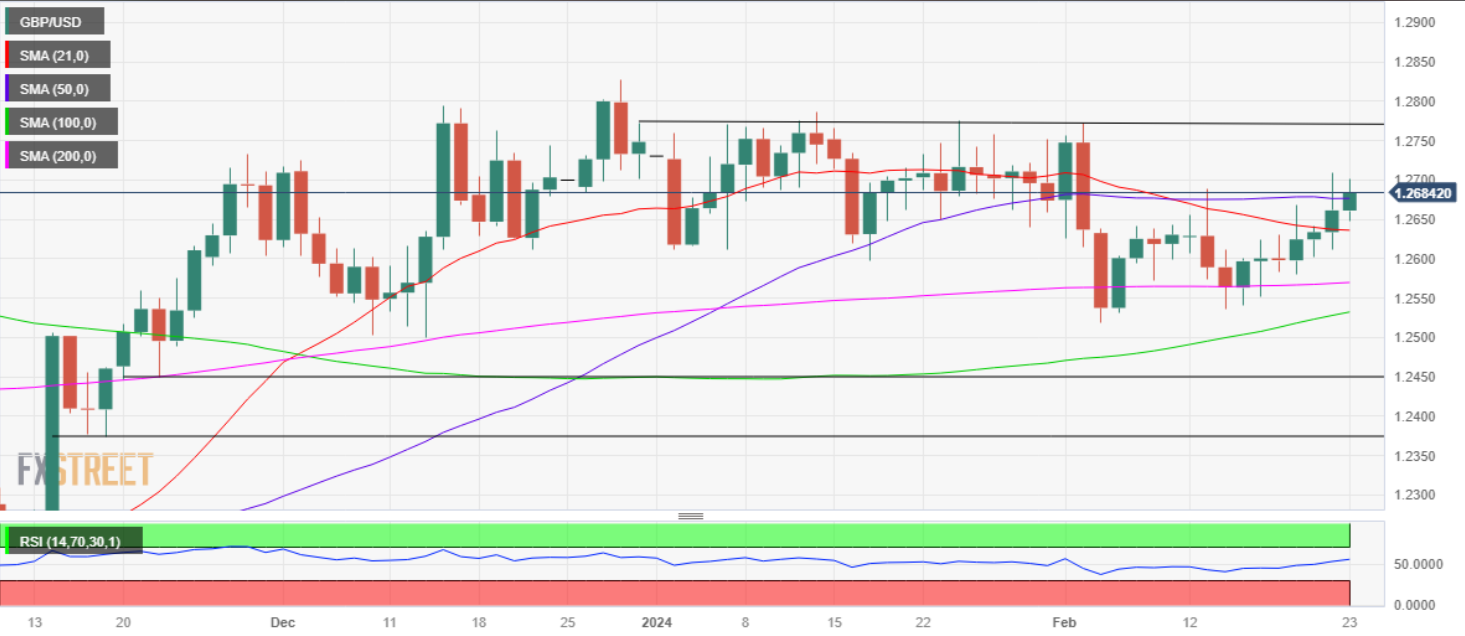- Pound Sterling staged a comeback on the US Dollar pullback.
- US economic data and Fedspeak to dominate GBP/USD price action next week.
- Looking ahead, GBP/USD is set to extend its upswing so long as 200-day SMA holds.
The Pound Sterling (GBP) booked the first weekly gain against the US Dollar (USD), snapping a five-week bearish momentum. GBP/USD staged a comeback from weekly lows to hit a fresh three-week high just above 1.2700.
Pound Sterling benefits from sustained US Dollar weakness
The sentiment around the US Federal Reserve (Fed) interest rate cut expectations drove the GBP/USD price action in the holiday-shortened week. The pair maintained the previous week’s range, trading subdued on Monday, as American traders enjoyed a long weekend on account of the Presidents’ Day holiday.
Thereafter, GBP/USD picked up the recovery momentum, as the US Dollar maintained a submissive tone, despite increased bets for delayed Fed rate cuts amid hawkish FOMC Minutes and commentaries from Fed officials.
Further, mixed US economic data releases combined with the AI optimism-led tech boost and global stock rally kept the downbeat tone intact around the US Dollar. US S&P Global Manufacturing PMI improved to 51.5 from 50.7 in February, while S&P Global Services PMI edged lower to 51.3 from 52.5. Meanwhile, US Initial Jobless Claims fell by 12,000 to 201,000 for the week ending February 17, the Labor Department reported Thursday.
GBP/USD rallied as high as 1.2709 amid a sustained US Dollar retreat. Still, Pound Sterling sellers returned at higher levels as they weighed the dovish comments from Bank of England (BoE) Governor Andrew Bailey, delivered during his testimony before the UK Parliament’s Treasury Select Committee (TSC) in the early part of the week.
Bailey said, "we don't need inflation to be back at the target before cutting rates." "Markets expect rate cuts this year, we do not endorse the market curve, but it is not unreasonable for the market to think that," he added.
The Pound Sterling struggled to hold on to its renewed upswing, as the downside in the US Dollar was cushioned by buoyant US Treasury bond yields. US yields drew support from the Fed policymakers’ continued pushback against early and aggressive Fed rate cuts.
Additionally, mixed S&P Global UK Manufacturing and Services PMI data also sapped the confidence of Pound Sterling buyers, especially after the UK economy entered a technical recession. The seasonally adjusted S&P Global/CIPS UK Manufacturing PMI improved slightly from 47.0 in January to 47.1 in February, below the market consensus of 47.5. Meanwhile, the Preliminary UK Services Business Activity Index stayed unchanged at 54.3 in February, beating the consensus forecast of 54.1.
Week ahead: Top-tier US data in focus
Following a holiday-shortened and relatively data-light week, GBP/USD traders look forward to a host of top-tier US economic data releases, as the UK calendar remains a quiet one.
Monday will see a couple of BoE policymakers speaking, followed by the US New Home Sales data. BoE officials Sarah Breeden and Huw Pill will take up the rostrum. On Tuesday, the US Durable Goods Orders and Conference Board Consumer Confidence data will keep traders entertained. BoE policymaker Dave Ramsden will also make an appearance that day.
The US docket will feature the second estimate of the fourth-quarter Gross Domestic Product (GDP) on Wednesday alongside the release of the Personal Spending and Personal Income data.
The US weekly Jobless Claims will be reported on Thursday but the key focus will be on the Core Personal Consumption Expenditures (PCE) - Price Index, the Fed’s preferred inflation gauge.
Friday will be a busy day, with the final prints of the S&P Global UK and US Manufacturing PMI on the cards. However, the main event risk will be the ISM Manufacturing PMI.
Markets will continue to closely scrutinize the speeches from the Fed policymakers for gauging the timing of the first-rate cut this year.
GBP/USD: Technical Outlook
The short-term outlook for GBP/USD suggests that the recovery momentum is likely to gather traction on a sustained break above the 50-day Simple Moving Average (SMA) at 1.2678.
The 14-day Relative Strength Index (RSI) is sitting just above the 50 level, suggesting that there is more room for upside in the pair.
If the Pound Sterling buyers manage to close the week above the 50-day SMA at 1.2678, a fresh uptrend could be initiated toward the 1.2750 psychological barrier.
The next topside barrier for the pair is seen at the static resistance near 1.2775. The December 28 high of 1.2828 will be next on the buyers’ radars.
On a failure to close the week above the 50-day SMA of 1.2678, Pound Sterling could see a temporary pullback toward the 200-day SMA at 1.2570.
However, the 21-day SMA at 1.2630 could offer some support to Pound Sterling buyers prior.
A convincing break below the 200-day SMA at 1.2570 will put the 100-day SMA at 1.2532 in sight. Further south, the 1.2450 psychological level could test bullish commitments.
Pound Sterling FAQs
What is the Pound Sterling?
The Pound Sterling (GBP) is the oldest currency in the world (886 AD) and the official currency of the United Kingdom. It is the fourth most traded unit for foreign exchange (FX) in the world, accounting for 12% of all transactions, averaging $630 billion a day, according to 2022 data.
Its key trading pairs are GBP/USD, aka ‘Cable’, which accounts for 11% of FX, GBP/JPY, or the ‘Dragon’ as it is known by traders (3%), and EUR/GBP (2%). The Pound Sterling is issued by the Bank of England (BoE).
How do the decisions of the Bank of England impact on the Pound Sterling?
The single most important factor influencing the value of the Pound Sterling is monetary policy decided by the Bank of England. The BoE bases its decisions on whether it has achieved its primary goal of “price stability” – a steady inflation rate of around 2%. Its primary tool for achieving this is the adjustment of interest rates.
When inflation is too high, the BoE will try to rein it in by raising interest rates, making it more expensive for people and businesses to access credit. This is generally positive for GBP, as higher interest rates make the UK a more attractive place for global investors to park their money.
When inflation falls too low it is a sign economic growth is slowing. In this scenario, the BoE will consider lowering interest rates to cheapen credit so businesses will borrow more to invest in growth-generating projects.
How does economic data influence the value of the Pound?
Data releases gauge the health of the economy and can impact the value of the Pound Sterling. Indicators such as GDP, Manufacturing and Services PMIs, and employment can all influence the direction of the GBP.
A strong economy is good for Sterling. Not only does it attract more foreign investment but it may encourage the BoE to put up interest rates, which will directly strengthen GBP. Otherwise, if economic data is weak, the Pound Sterling is likely to fall.
How does the Trade Balance impact the Pound?
Another significant data release for the Pound Sterling is the Trade Balance. This indicator measures the difference between what a country earns from its exports and what it spends on imports over a given period.
If a country produces highly sought-after exports, its currency will benefit purely from the extra demand created from foreign buyers seeking to purchase these goods. Therefore, a positive net Trade Balance strengthens a currency and vice versa for a negative balance.
Information on these pages contains forward-looking statements that involve risks and uncertainties. Markets and instruments profiled on this page are for informational purposes only and should not in any way come across as a recommendation to buy or sell in these assets. You should do your own thorough research before making any investment decisions. FXStreet does not in any way guarantee that this information is free from mistakes, errors, or material misstatements. It also does not guarantee that this information is of a timely nature. Investing in Open Markets involves a great deal of risk, including the loss of all or a portion of your investment, as well as emotional distress. All risks, losses and costs associated with investing, including total loss of principal, are your responsibility. The views and opinions expressed in this article are those of the authors and do not necessarily reflect the official policy or position of FXStreet nor its advertisers. The author will not be held responsible for information that is found at the end of links posted on this page.
If not otherwise explicitly mentioned in the body of the article, at the time of writing, the author has no position in any stock mentioned in this article and no business relationship with any company mentioned. The author has not received compensation for writing this article, other than from FXStreet.
FXStreet and the author do not provide personalized recommendations. The author makes no representations as to the accuracy, completeness, or suitability of this information. FXStreet and the author will not be liable for any errors, omissions or any losses, injuries or damages arising from this information and its display or use. Errors and omissions excepted.
The author and FXStreet are not registered investment advisors and nothing in this article is intended to be investment advice.
Recommended Content
Editors’ Picks

EUR/USD hovers around 1.0800 on Fed's decision
EUR/USD returned to the 1.0800 price zone after the Federal Reserve announced its decision to cut the benchmark interest rate by 25 bps as widely anticipated. Chair Jerome Powell's remarks put mild pressure on the US Dollar.

USD/JPY retreats from weekly highs as FOMC delivers 25 bps rate trim
USD/JPY hovers around 153.80 after the Fed broadly met market expectations on November's rate call. The Fed delivered a follow-up quarter-point cut on Thursday; markets now bet on the odds of a December three-peat.

Gold regains $2,700 with Fed’s announcement
Gold extends its recovery following Wednesday's sharp decline and trades above $2,700, as the US Dollar eases following the Federal Reserve's decision to cut rates by 25 bps. Powell's speech revolved around Trump's victory.

Ethereum Price Forecast: ETH eyes $3,366 as open interest growth could fuel quest for new all-time high
Ethereum (ETH) is up nearly 8% on Thursday and could reach a new all-time high before year-end following increasing investor demand for the top altcoin. This is visible in ETH's open interest growth and increasing Ethereum exchange-traded funds (ETF) inflows.

Outlook for the markets under Trump 2.0
On November 5, the United States held presidential elections. Republican and former president Donald Trump won the elections surprisingly clearly. The Electoral College, which in fact elects the president, will meet on December 17, while the inauguration is scheduled for January 20, 2025.

Best Forex Brokers with Low Spreads
VERIFIED Low spreads are crucial for reducing trading costs. Explore top Forex brokers offering competitive spreads and high leverage. Compare options for EUR/USD, GBP/USD, USD/JPY, and Gold.

